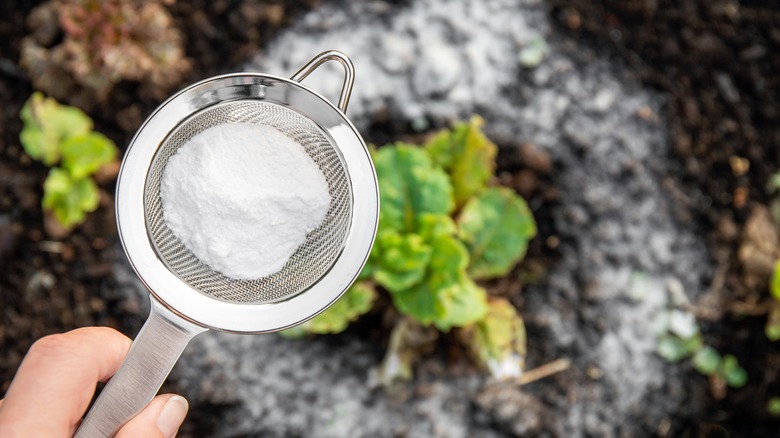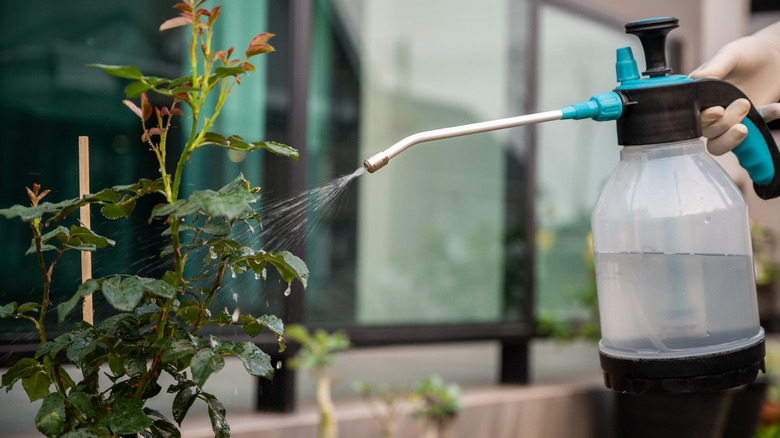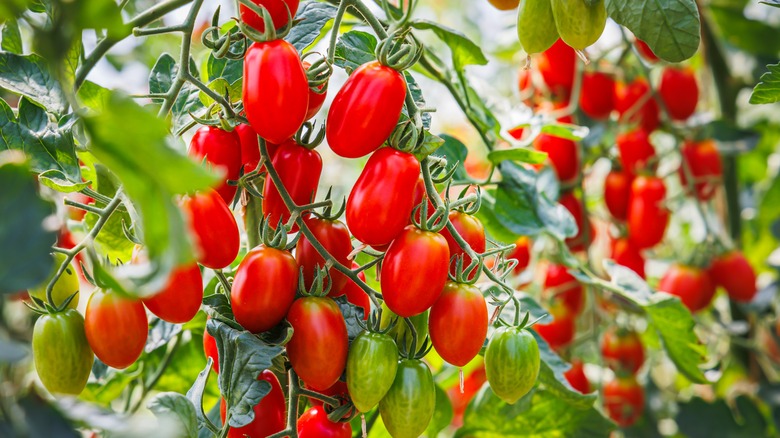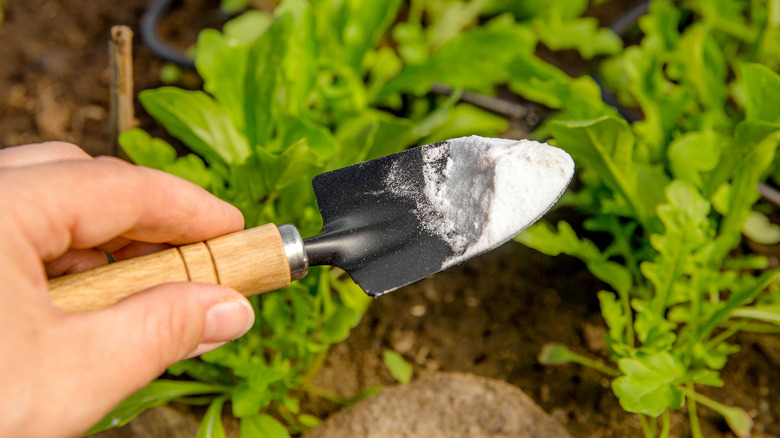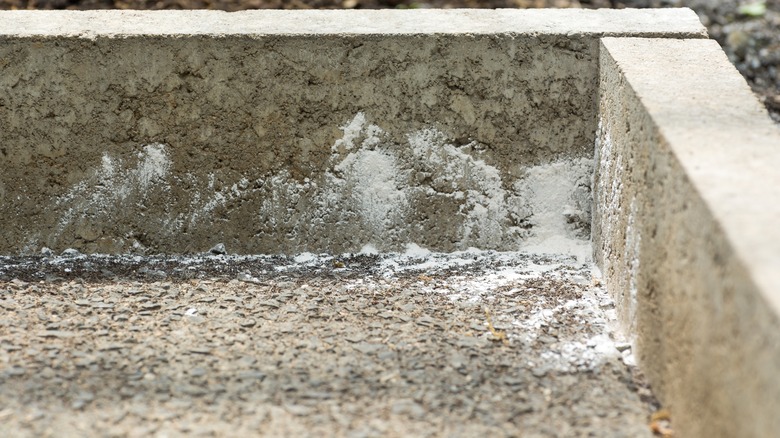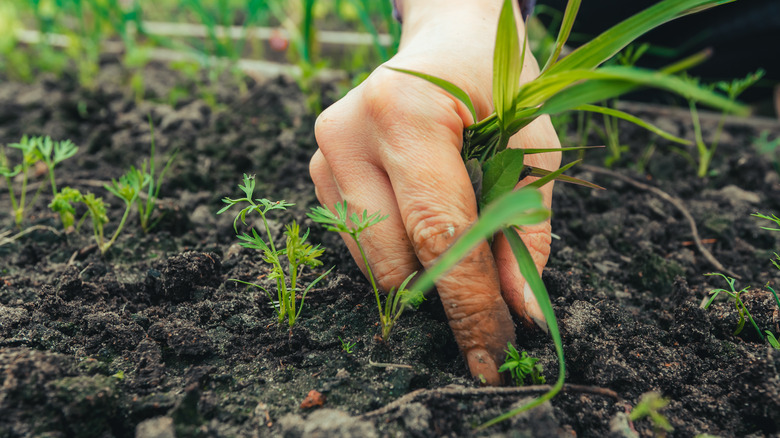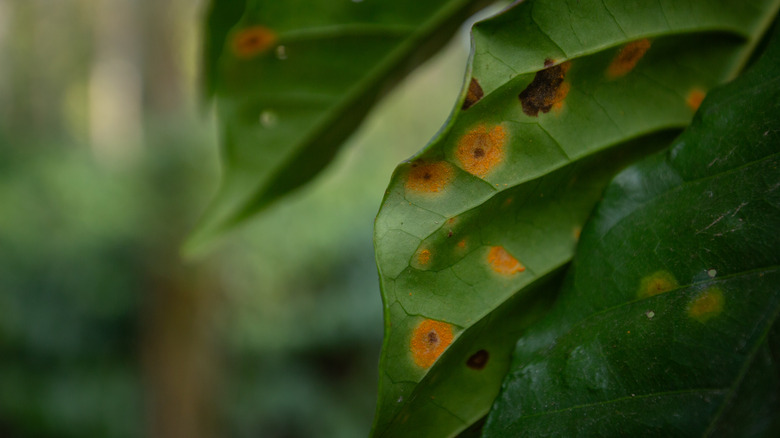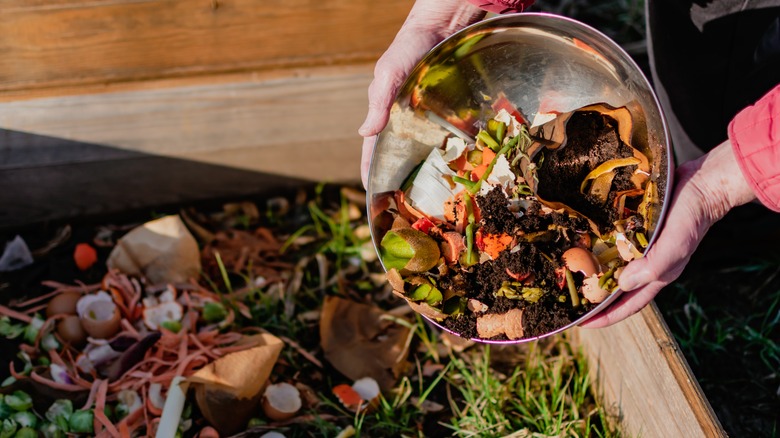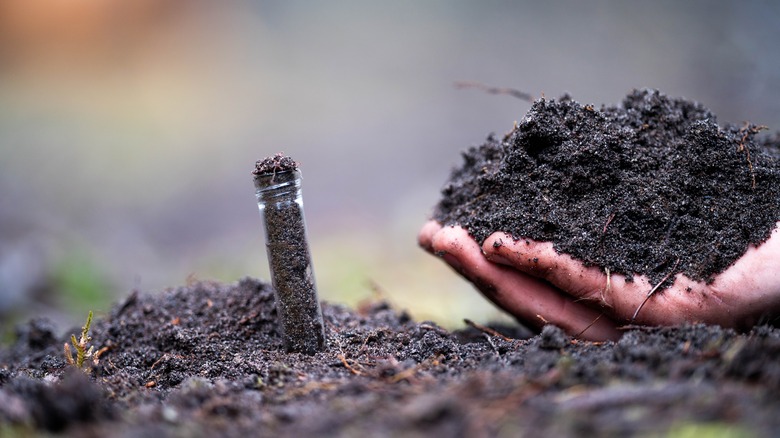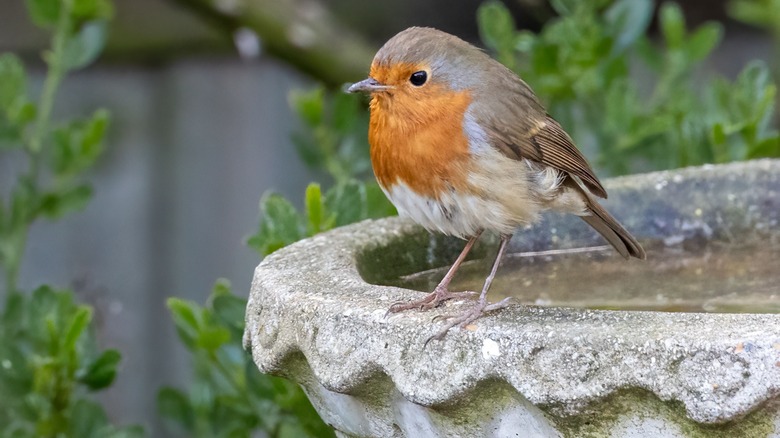Mistakes Everyone Makes When Using Baking Soda For A Better Lawn & Garden
Many home gardeners often reach for baking soda as an alternative to harsh chemicals in their lawns. The powder is thought to be a gentler weed killer for flower beds, able to keep pesky insects away from your favorite plants, make your flowers more colorful, and make your fruits taste just that much sweetener. However, while it might be able to do some of that, it's not the be-all-end-all gardening aid some make it out to be.
Many of these tips are actually false facts about baking soda that won't get you very far. And if they do work, you want to make sure you're applying the powder in such a way that gets you maximum results. In order to ensure you're not struggling with bunk tips or applying tried-and-true hacks incorrectly, we've rounded up all the mistakes people make when using baking soda in their landscaping. By adjusting your actions based on this advice, your garden will thrive because you will be giving it exactly what it needs.
Applying it as a pesticide
If you have a pest problem, you will need more than just baking soda to get rid of the bugs in your garden. While it might slow the spread of fungal diseases in plants when combined with Neem oil, it won't help you attack any insects. While some sites claim that the powder will dehydrate pests, it does no such thing. Instead, these sources may be mixing up baking soda with diatomaceous earth, which is also white but made from fossilized diatoms. They are sharp and jagged on a molecular level, and when insects come into contact with them, the powder creates abrasions on their exoskeletons, dehydrating and eventually killing them. Other sources claim that baking soda's alkalinity will kill the pests, but it doesn't have much of an effect. In most cases, people add horticultural oils like Neem oil or soaps in these recipes, which do most of the heavy lifting. Without these, nothing much will happen, as baking soda alone is not effective at killing insects.
How did this myth arise? Most sites pushing this tip link back to a 2017 study in the Journal of Agricultural and Food Chemistry, which found that the powder was able to remove pesticide residue from picked produce. However, that's it. There is no research on its ability to act as a pesticide; it just washes away pesticides. Instead, if you want a way to repel bugs naturally, consider using cloves or cayenne pepper — which pests actually do hate. However, these ingredients will not kill them, only repel them.
Using it to make your fruit sweeter
"Use baking soda to make fruit sweeter" is a myth that is tough to get away from because even the leading manufacturer of the product, Arm & Hammer, tends to perpetuate it. The company states that, when planting tomato seedlings, sprinkling baking soda into the soil will make them taste sweeter when they are done growing. Because of this endorsement, many home and garden bloggers have run with the advice.
However, there is no scientific evidence to support this hack. Besides Arm & Hammer's claim, the idea likely comes from the fact that many think the alkalinity of baking soda will change the PH of the soil, thus the taste of the plant. Yet, this hasn't been proven to work. Instead, if you want sweet fruit, just let it ripen on the vine a little bit longer. The more ripe a fruit is, the sweeter it will taste.
Using baking soda as a fertilizer
If you want your plants to grow strong with the essential nutrients they need, don't sprinkle baking soda on all of their roots, mix it in their soil, or dust it on their leaves. It's not a fertilizer, although many might make the mistake of thinking that it is. The reason baking soda won't work in this way is that it can't provide essential nutrients for plant growth. Plants need nitrogen, phosphorus, and potassium to thrive, and the powder doesn't give a boost to that. In fact, instead of providing fuel for your plants, the powder is actually full of salt, which can lead to potential harm and toxicity.
As baking soda is a form of sodium bicarbonate, most research points to it negative impact on plants rather than its benefits. For instance, a 2013 study in the international journal Acta Physiologiae Plantarum found that its presence restricts root growth and negatively impacts a plant's ability to photosynthesize. For a more natural option that will work, consider using compost to fertilize your lawn instead.
Using the powder to disrupt ant scent trails
When you find rouge ants roaming your greenhouse or poking around your backdoor, it can be tempting to try and stop the stragglers using baking soda. Yet it's a mistake to disrupt their path into your house as it won't do much to solve the bigger problem. While it is true that ants follow a scent trail to find food and bring it back to the colony, placing baking soda in the way is only a temporary solution. It will act like a wall for a little while, but they will eventually find their way around it as ants tend to be great at redirecting themselves to and from a food source. To ensure that the ants don't storm back into your kitchen or greenhouse, you need to kill all of them at the source.
To do this with baking soda, you can apply it to the mound as a poison to see quick, lasting results, but it still might not get rid of all of them if you don't do it right. The ants need to ingest the powder for it to work correctly, but they might not be attracted to it on its own because it's so salty. Instead, pest experts have anecdotally found that if you mix the soda with powdered sugar to attract them, then sprinkle that on and in the mound, the insects are more likely to eat it and perish, leaving you with a pest-free place. However, while this hack will kill species like carpenter ants, it won't kill fire ants.
Using it to kill weeds
Using baking soda to kill weeds in your garden is a dangerous tactic. It works really well because of the excess salt in the powder. Baking soda is sodium bicarbonate, so typically it works as an herbicide by sprinkling it directly into the dirt around the weeds you want to get rid of. Because of its strong salty makeup, it will either absorb the surrounding water in the dirt, making it difficult for the weed to pull up enough moisture, or effectively kill it. Or, if you add enough, it will create salt toxicity, which will burn the plant and kill it. However, it can also kill any chances you might have of growing anything else there, either.
The salt in baking soda can change the soil's structure, displace important nutrients with sodium, and inhibit water filtration, so using it to kill weeds is a mistake. Of course, you might not get such extreme results taking out a weed or two, but if you use this as your main remedy for weed removal, you will be consistently salting the earth, eventually making the dirt unusable. Instead, there are less harmful ways to kill weeds in your lawn, like careful weeding by hand, regular mulching, and even flaming them. These methods are better than the mistake with baking soda as they don't have the possibility of destroying your lawn for future use.
Using baking soda to kill fungus in your garden
If you notice fungus destroying your favorite plants, it might be tempting to reach for baking soda to dust across its leaves. There is an old rumor that doing this will stop the fungus in its tracks and save your plant. Unfortunately, this would be a mistake as the evidence that baking soda kills fungi is from a study from the 1930s, which has since been debunked. More recent studies have found that baking soda doesn't kill the fungus, but its high alkalinity will stop it from growing if you use high enough concentrations. However, if the environment lowers in alkalinity, the fungus can continue to progress.
Another caveat is that baking soda alone won't be effective at stopping fungal diseases. Instead, you will have to combine it with a horticulture oil such as Sunspray or Volck oil. However, this remedy can be tricky since different fungal diseases will need different amounts to be treated properly. That's why there are so many different formula ratios on the internet — it takes some experimenting to get it right for your particular plant and predicament. But this experimenting can be detrimental: Too little and the environment won't be alkaline enough to stop the fungus, but too much and you create sodium toxicity. Because of this, it's best to use a more predictable remedy. Both potassium bicarbonate and ammonium bicarbonate have yielded better results, don't need the addition of horticultural oil, and have the added benefit of supplying nitrogen and potassium to the plant to help it better fight off its disease.
Sprinkling the powder on top of your compost pile
If your compost smells bad, you might think baking soda can help. It's an easy mistake to make, as using boxes of baking soda in the refrigerator can keep out strong odors. However, it can make things worse because it's a way of ignoring the problem, not fixing it. The problem is that compost isn't meant to smell bad at all. If yours is putting you off with noxious fumes, it means you need to address the underlying issue.
To avoid creating a stinky compost pile to begin with, never add scraps of meat or dairy, as these can rot and stink. Unpleasant smells can also indicate that the moisture level is too high. To fix this, you need to expose the pile to the sun by propping up the lid so it can dry out. You can also add more "brown" ingredients to the mix, like newspaper, twigs, or cardboard, to balance out the organic matter, making the pile less wet and odorous. Sometimes the smell also comes from a lack of oxygen in the compost, so you should use a shovel or rake to agitate the pile and bring fresh air to it. These things will actually make it smell better by addressing the root cause.
Using baking soda to test soil directly in the garden
In the gardening community, a popular hack to discover the soil's pH is to use baking soda. However, it won't give you accurate results if you just sprinkle some powder on the soil and wait for a reaction. Instead, you must take at least 2 tablespoons of soil and place it in a clean container. Mix 1/2 cup of water and 1/2 cup of baking soda and pour it into the soil. The water allows the baking soda to penetrate the dirt. Look for a fizz — if it's there, your soil leans acidic. If nothing happens, but fizz appears when repeated in a new jar with vinegar, you have more alkaline soil.
However, these results shouldn't have you racing to amend your soil. You don't know its exact pH measurement, so you won't be able to alter the soil safely. For instance, if your dirt has a pH level of 2, it's very acidic and will need more altering than a pH level of 5. Instead, send your dirt to a university extension lab to be tested and get their professional recommendations on next steps. Or, invest in a pH test kit to get a more accurate reading of your soil's pH levels, such as the kit from The Seed Collection. This will give you a clearer picture of your soil's needs.
Forgetting to use it to clean accessories
While baking soda isn't much use for the plants in your garden or the grass in your lawn, there is actually a great use for it around the exterior of your home. Not using baking soda to clean accessories is a huge mistake! The powder is a great alternative to harsh chemicals for cleaning. You can use it to get grime off of your bird bath, tidy the outside of your flower boxes and plant pots, get stains off your concrete porch, and even freshen up garden furniture. It does this in two ways. First, it's a base, so it helps dissolve organic material like dirt or animal waste. Second, since it's made from minerals, it's a gentle abrasive that will help you lift grime without scratching the item's surface.
Of course, you can't simply sprinkle baking soda on any of these things and consider them clean. In most cases, you'll need to mix it with a liquid, such as water, to turn it into a paste. For more stubborn grime, consider mixing it with white or apple cider vinegar. This combination triggers a reaction that fizzes and releases carbon dioxide gas, helping to separate the gunk from the surface. However, this reaction also creates salt water if mixed in equal parts, which will neutralize both ingredients' cleaning properties. To avoid that, either add more acid or more base to your mixture, depending on what your particular mess requires.
